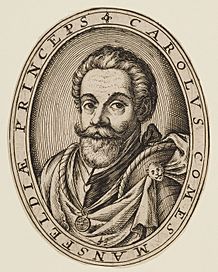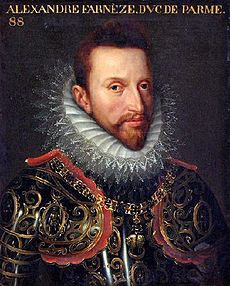Siege of Eindhoven (1583) facts for kids
Quick facts for kids Siege of Eindhoven (1583) |
|||||||
|---|---|---|---|---|---|---|---|
| Part of the Eighty Years' War and the Anglo-Spanish War (1585–1604) | |||||||
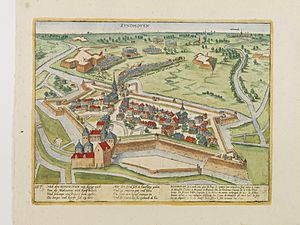 The Capture of Eindhoven of 1583 by Frans Hogenberg. |
|||||||
|
|||||||
| Belligerents | |||||||
| Commanders and leaders | |||||||
Supported by: |
|||||||
| Strength | |||||||
| 800 to 1,200 men Reinforced by: 4 cavalry squadrons 5 infantry companies |
Unknown | ||||||
| Casualties and losses | |||||||
| Unknown | Unknown | ||||||
The Siege of Eindhoven in 1583 was an important battle during the Eighty Years' War. This war was a long fight for independence by the Netherlands against Spain. The siege also happened during the Anglo-Spanish War, which involved England and Spain.
From February 7 to April 23, 1583, Spanish forces surrounded the city of Eindhoven. This city in North Brabant (part of today's Netherlands) was very important. It was defended by soldiers from the Netherlands, Scotland, and France. Their commander was Hendrik van Bonnivet.
The Spanish army was led by Karl von Mansfeld and Claude de Berlaymont. They were sent by Don Alexander Farnese, who was the Spanish Governor-General. After three months, the defenders of Eindhoven had to give up. The Spanish army won the battle on April 23.
This victory helped Spain gain control over more towns in northern Brabant. It also caused problems between the Duke of Anjou (a French leader) and the Dutch government. Even William of Orange tried to keep their alliance strong.
Contents
Why the Siege Happened: The Background
The Eighty Years' War was a big conflict. The Dutch provinces wanted to be free from Spanish rule. In 1580, Francis, Duke of Anjou, who was the brother of the French King, agreed to help the Dutch. He signed a deal called the Treaty of Plessis-les-Tours.
This treaty made Anjou the "Protector of the Liberty of the Netherlands." He became the ruler of the United Provinces. In 1582, Anjou arrived in the Netherlands. William of Orange welcomed him.
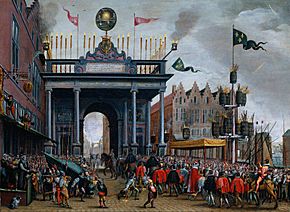
However, many Dutch and Flemish Protestants did not trust Anjou. He was Catholic, and they saw the French as enemies. Some provinces, like Zeeland and Holland, refused to accept him as their ruler. William of Orange, who wanted peace between different religions, was criticized for trusting the French.
Anjou brought a large army of 12,000 foot soldiers and 5,000 horsemen. At first, it seemed like William's plan was working. Even the Spanish leader, Don Alexander Farnese, worried about a strong French-Dutch alliance. But Anjou felt he didn't have enough power.
In January 1583, Anjou's French forces tried to secretly take the city of Antwerp. This event is known as the French Fury. But the people of Antwerp found out. They remembered a terrible Spanish attack seven years earlier. So, they fought back hard. Anjou's army was badly defeated, losing many soldiers.
Even though Anjou failed in Antwerp, his other forces took control of several towns like Dunkirk and Dendermonde. Despite strong anti-French feelings, William of Orange managed to prevent a complete break with the French.
Meanwhile, the Prince of Parma (Don Alexander Farnese) was the Spanish Governor-General. He commanded a huge army of 60,000 soldiers. He had already captured many important cities. He paused his campaign to see what the French would do next.
The Siege of Eindhoven Begins
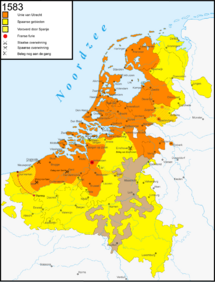
After the Duke of Anjou's failed attack on Antwerp, Don Alexander decided to act. He was based in 's-Hertogenbosch, a city loyal to Spain. He sent a strong force to Eindhoven. This force was led by Spanish commanders Karl von Mansfeld and Claude de Berlaymont.
Eindhoven was a key city in northern Brabant. It was defended by about 800 to 1,200 soldiers. These soldiers were from Scotland, France, and the Netherlands. Their commander was Hendrik van Bonnivet.
On February 7, the Spanish army reached Eindhoven. They surrounded the city and began the siege. The Dutch government (the States-General) asked the Duke of Anjou to gather his army and march to Eindhoven to help the city.
Meanwhile, Philip of Hohenlohe-Neuenstein sent help to Bonnivet. He sent 4 groups of horsemen and 5 companies of foot soldiers from his base at Geertruidenberg.
On March 18, Anjou agreed to help. William of Orange then asked a French commander, Armand de Gontaut, Baron de Biron, to lead a relief army. This army would combine Anjou's troops with those raised by the Dutch.
Biron was not eager to lead, but a French official convinced him. William of Orange planned the campaign. Biron's army included 2,500 Swiss guards, 2,000 French soldiers, 3,500 Dutch, Scottish, French, and English foot soldiers, 1,200 horsemen, and 3 cannons.
Dutch troops from Gelderland were ordered to advance through Utrecht. But Spanish forces repeatedly pushed them back. English and Scottish companies in northern Flanders also had orders to move towards Eindhoven. However, these troops refused to fight without being paid.
On April 17, Biron's relief army finally marched towards Eindhoven. But it was too late for the city's defenders. After nearly three months, Bonnivet's forces were tired and weakened. They could not hold out against the strong Spanish attack any longer.
Finally, on April 23, the Dutch garrison in Eindhoven had to surrender. The Spanish army marched into Eindhoven as victors. Biron's relief forces had not even crossed the Scheldt river yet.
What Happened Next
With Eindhoven captured, Parma's Spanish forces made big gains in the region. Most towns in northern Brabant then joined the Spanish side. This Spanish victory also made the problems between the Duke of Anjou and the Dutch government even worse.
Anjou blamed the Dutch for Eindhoven's fall. The Dutch were tired of his demands and his army's slow actions. However, William of Orange still believed they needed French help to defeat Parma.
Biron moved his army north to an area between Breda and Bergen op Zoom. He planned to lay siege to Wouw. But on June 17, his forces were badly defeated by Parma's Spanish army at Steenbergen.
The Spanish army was much stronger. Also, Biron's troops had not been paid. There were also disagreements between the French (mostly Catholic) and the Dutch and English (mostly Protestant) soldiers. Hundreds of Biron's troops deserted.
Anjou's position with the Dutch became impossible. He finally left the Netherlands in late June. His departure also made William of Orange, who had supported him, look bad. But William still believed in the alliance with Anjou.
The Spanish army continued its advance. Their next target was Dunkirk. On July 16, the Spanish began bombarding the city. By late summer, Dunkirk was captured by Spanish forces. Nieuwpoort was also taken. William of Orange tried again to help the besieged cities, but he failed.
See also
- French Fury
- French Wars of Religion
- Treaty of Plessis-les-Tours
- List of stadtholders in the Low Countries
- List of governors of the Spanish Netherlands
Images for kids


